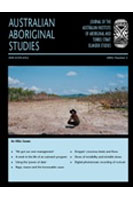Australian Aboriginal Studies: Issue 2, 2005
Abstracts for Issue 2, 2005
We got our own management’: local knowledge, government and development in Cape York Peninsula
Benjamin Richard Smith
In examining the growing interrelationship of local knowledge and projects of government among Aboriginal Australians I draw on ethnographic material to reveal the tensions and complexities of land- and naturalresource management involving Aboriginal ‘traditional owners’. I also analyse the ways in which the concept of management - a key term in local critiques of introduced forms of governance—itself reveals the growing interrelation of originally distinct indigenous and exogenous systems. This process of interrelation has affected not only the articulation of Aboriginal identities, but is also implicated in the current importance of local cosmological figures.
Lungmarama Yolngu nha: a week in the life of an outreach program
Ben Wearne, Janice Chesters and Sue Whyte
The Yolngu of north-eastern Arnhem Land have lived with alcohol for just over 30 years. For some, particularly those who permanently or transiently camp on the fringes of the predominantly non-Indigenous township of Nhulunbuy, it has resulted in devastating health, social, family and cultural impacts. The Miwatj Health Aboriginal Corporation Outreach Program is a response to alcohol use by this Aboriginal community. We examine the outreach program in terms of its conception and development and ‘success’. The impact that funding (or lack of funding), the funding source, and different expectations by the Indigenous and non-Indigenous communities can have on the success or otherwise of such a program are manifest in this case study. Extracts from a journal written by one of the researchers while involved in the program provides a grounded insight into the practicalities and realities of undertaking this type of activity in a remote community.
The outreach program has achieved some success by helping a small number of Yolngu to turn their lives around and move off a path of self-destructive alcohol use. However, the program has been narrowly fashioned and continues to be driven by the concerns of the non-Indigenous community for whom its ‘success’ has been the attention given to litter and antisocial behaviour
Using the ‘power of the data’ within Indigenous research practice
Maggie Walter
Quantitative methods, especially when used on large-scale data sets such as NATSIS and census collections, are powerful analytical research tools. Yet the use of such methods is relatively rare among Indigenous Australian researchers. Reasons for this limited engagement include the fraught relationship between Indigenous peoples and research, the lack of an established Indigenous presence within quantitative research practice, and the paucity of relevant Indigenous quantitative data. Three arguments for the greater use of quantitative methods and techniques within Indigenous research practice include the research power available through the use of such methods, the need for an Indigenous presence in this field of research, and the capacity of an Indigenous research framework to transform quantitative research practice.
Rage, reason and the honourable cause: a reply to Cowlishaw
Peter Sutton
In 2003 Gillian Cowlishaw published a confrontational attack on a paper that I had published earlier on the subject of ‘The politics of suffering’ in Aboriginal Australia. While this reply takes up and answers her main points, it also examines her writings more generally and comes to a critical view of the use of the anthropological literary framework in the pursuit of political ends. The politicisation of anthropological and historical writing on Indigenous themes in recent decades has focused unwarranted attention on the moral position of the author, and has been running in reverse gear against the long-term trend of secularisation and objectification encouraged in Western thought since the Enlightenment. I suggest it’s time for a little classicism.
Droppin’ conscious beats and flows: Aboriginal hip hop and youth identity
George Stavrias
Hip hop culture is significant in Aboriginal youth identity formation. I examine the culture of ‘conscious’ Australian hip hop as practised by three hip hoppers from the East Coast: Little G and MC Wire, both Aboriginal, and Morganics, a Settler who conducts hip hop workshops for Aboriginal youth. In dispelling the myth of American cultural imperialism, I argue that hip hop’s critical appropriation has as much to do with its internal logic of sampling, representin’ and flow as with the oppositional politics it often serves as a vehicle.
Shoes of invisibility and invisible shoes: Australian hunters and gatherers and ideas on the origins of footwear
Kim Akerman
Apart from a single brief paper written by DS Davidson and published in 1947, and a detailed description of bark sandals from the Tanami desert region by DF Thomson in 1960, most attention in relation to Aboriginal Australian footwear has focused on the emufeather and hairstring kadaitcha shoes or slippers of Central Australia. While footwear was lacking among most indigenous Australians, at least five different forms of indigenous footwear or foot protection have been recorded. A revised distribution of Aboriginal footwear is presented here. Early records draw attention to the use of footwear among the Tasmanian Aborigines and offer insights into the possible origins of the use of footwear.
While traditionally footwear had a limited distribution on the continent, the use of at least one form intimately associated with magical killing and sorcery, the kadaitcha shoe, seems to have been spreading in the late nineteenth and early twentieth centuries. It is suggested here that internal disruption caused by the impact of Western and Asian societies in the nineteenth century led to an increase in aberrant behaviour, including sorcery, that may account for the spread of this particular type of footwear.
